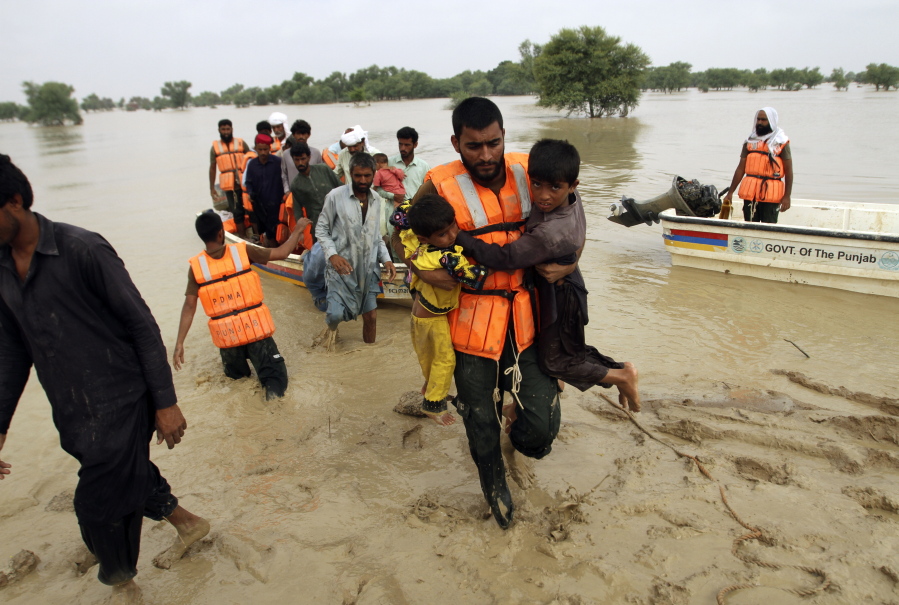ISLAMABAD (AP) — Pakistanis wrestled with the destruction of their homes and businesses Monday as the military and volunteers tried to evacuate thousands stranded by widespread flooding driven by “monster monsoons” that have killed more than 1,000 people this summer.
In the southeastern town of Shikar Pur not far from the Indus River, Rehan Ali dug up bricks from the collapsed walls of his home, nearly completely destroyed by lashing storms and waters that raged through. His family’s possessions were strewn around outside.
The 24-year-old laborer said he cannot rebuild without government help and can’t work now because of the turmoil. “I don’t even have anything to feed my family. I lost everything. I don’t know where to go. God help me,” he said.
International aid was starting to flow into Pakistan after the country appealed for help from what officials say is a disaster fueled by climate change. Monsoon storms, heavier and earlier than usual, have hit Pakistan hard the past week — most recently with massive rains last week that effected nearly the entire country.
Flash floods have affected 33 million Pakistanis, damaged nearly 1 million homes and killed at least 1,061 people, officials said.
Though rains stopped two days ago, large areas in parts of the country were still covered with water Monday, up to a meter (yard) high in some places, particularly in the south, witnesses said. Weather forecasts predicted dry conditions for the coming days, offering hope flooding will recede for now.
Prime Minister Shabaz Sharif on Monday said the rains are the heaviest Pakistan has seen in three decades.
“I saw floodwater everywhere, wherever I went in recent days and even today,” Sharif said in the town of Charsadda in the northeast of the country. Some 180,000 people in the town have been evacuated after the Swat River overflowed and swamped nearby communities.
Sharif has said the government would provide housing to all those who lost their homes.
But many of the displaced have lost not just homes, but also crops and businesses.
“I am sitting with my family in a tent, and how can I go out to work? Even if I go out in search of a job, who will give me any job as there is water everywhere,” asked Rehmat Ullah, a flood victim in Charsadda.
Zarina Bibi said soldiers evacuated her by boat. She broke down in tears as she recounted how her house collapsed in the floods.
“We were given a tent and food by soldiers and volunteers,” she said. “Floodwater will recede soon, but we have no money to rebuild our home.”
Sherry Rehman, Pakistan’s climate minister, has described the unusual rainfall as a “monster monsoon.” She says the heavy rains are the latest in a series of catastrophes exacerbated by climate change, including heatwaves, forest fires and glacial lake outbursts.
The floods destroyed more than 150 bridges and numerous roads have been washed away, making rescue operations difficult. At least 6,500 soldiers were deployed to help, and authorities said they were using military planes, helicopters, trucks and boats to evacuate people from marooned people and deliver aid to them.
However, many displaced complained they were still waiting for help. Some said they got tents but not food.
Pakistani authorities say this year’s devastation is worse than in 2010, when floods killed 1,700 people. Gen. Qamar Javed Bajwa, Pakistan’s military chief, said Sunday that his country may take years to recover. He appealed to Pakistanis living abroad to generously donate to the flood victims.
Cargo planes from Turkey and the United Arab Emirates began the flow of international aid, landing in Islamabad on Sunday with tents, food and other daily necessities. Pakistan’s National Disaster Management Authority was sending out trucks of supplies to hard-hit areas.
The United Nations will launch an international appeal for Pakistani flood victims on Tuesday in Islamabad.
The flood wreckage has hit Pakistan at a time when the country faces one of its worst economic crises, narrowly avoiding a default. Later on Monday, the International Monetary Fund’s executive board was expected to approve the release of a much-awaited $1.7 billion for Pakistan.
Pakistan and the IMF originally signed the bailout accord in 2019. But the release of a $1.7 billion tranche has been on hold since earlier this year, when the IMF expressed concern about Pakistan’s compliance with the deal’s terms under former Prime Minister Imran Khan’s government.
Last week, the United Nations in a statement said that it has allocated $3 million for U.N. aid agencies and their partners in Pakistan to respond to the floods and this money will be used for health, nutrition, food security, and water and sanitation services in flood-affected areas, focusing on the most vulnerable.
Associated Press writers Mohammad Farooq in Shikar Pur, Sindh and Riaz Khan in Peshawar contributed to this story.




